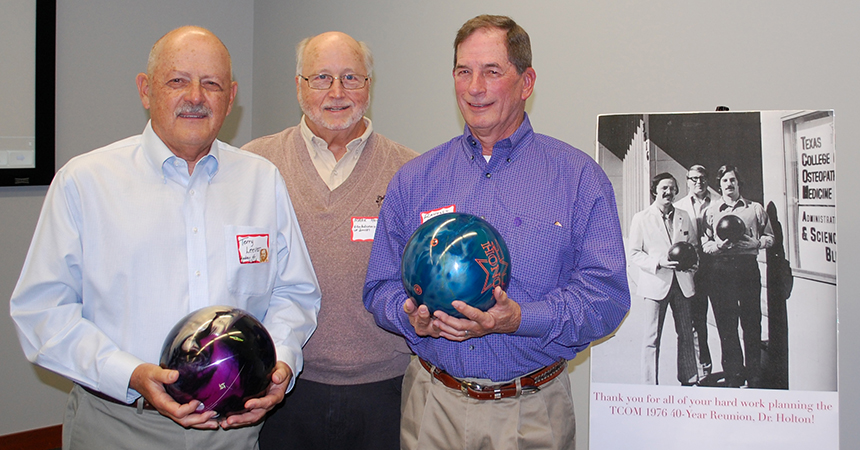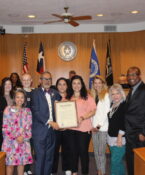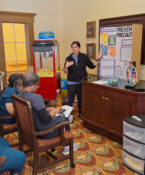We’ve come a long way
By Jan Jarvis
As a young medical student attending Texas College of Osteopathic Medicine in the 1970s, Mark Holton faced the challenges of developing the knowledge and skills to one day care for pediatric patients.
But there was more to his journey as an osteopathic medical student. He also faced the stigma of being seen as “less than” in the eyes of his allopathic peers. Things changed in four short years.
“By the time my class graduated TCOM, students were welcomed by JPS hospital and accepted by the medical community as real students and not as ‘those students’ at that other medical school,” Dr. Holton said.
Today, Dr. Holton is appreciative of the education he received, as well as the busy, rewarding career he has enjoyed as a pediatrician.
Like him, UNT Health Science Center has exhibited the same drive and vision to overcome obstacles and do great things in the 50 years since it was founded in 1970.
It, too, has been busy – advancing research, caring for the community and building a reputation as an innovator and champion of health care.
The Health Science Center is revolutionizing the diagnosis of Alzheimer’s disease, developing better ways to treat cancer and finding a cure for a blinding disease. Its researchers are working hard to discover ways to improve the lives of those with HIV and to help those with heart disease.
Monumental medical advances have occurred in UNTHSC’s first 50 years. They will be even more significant during its next 50 – particularly in the areas where UNTHSC is revolutionizing care: aging, cancer and eye diseases.
A cure for Alzheimer’s & longer, better lives
Fifty years ago, families watched helplessly as memory loss and odd behaviors robbed them of the grandparents they once knew.
It is hardening of the arteries, they were told. Or senility. Whatever the cause, there was nothing that could be done.
Much has changed since the 1970s.
Today, Alzheimer’s is a household word. The symptoms that once baffled a generation are now familiar and frightening.
“We had to reach the point where we could feel and appreciate the gravity of the problem and the complexity of it,” said Sid O’Bryant, PhD, Professor and Executive Director of the Institute for Translational Research. “We’ve come a long way since then.”
Five decades after the Health Science Center was founded, researchers are gaining ground in the battle to diagnose this baffling disease earlier and easier.
The first blood test to be used in a primary care setting is now in clinical trials. Developed by Dr. O’Bryant, it is destined to revolutionize the diagnosis and treatment of Alzheimer’s disease.
“We will be able to treat and prevent Alzheimer’s within the primary care office,” he said. “Within 20 years, I believe this will be in practice.”
Instead of waiting for memory lapses to occur, adults will be tested every year by their primary care doctors, Dr. O’Bryant said.
“We will understand the risks for different types of disease,” he said. “If someone looks like they are at risk, we will be able to immediately intervene.”
The same will be true for Parkinson’s disease and possibly other neurological diseases.
“We’ll get to the point when actually seeing a patient with Alzheimer’s will be rare,” he said. “I think we will be able to prevent it and preserve cognition.”
Currently, there are a few drugs on the market that slow the progression of Alzheimer’s, but nothing to cure it. Research is now underway to better understand the cause and develop a more personalized approach to treatment.
“Within 20 years, we will have dozens and dozens of new drugs,” Dr. O’Bryant said. “Within 50 years, I believe we will be able to cure this.”
And it’s not just Alzheimer’s disease where HSC is leading the way.
In the 1970s, geriatrics was in its infancy. Most people did not envision living vigorous lives into their 80s and 90s.
As pioneers in healthy aging, HSC researchers have played a significant role in helping people live well longer.
Geriatrics has grown into a specialty that every HSC student is exposed to during his or her studies, said Janice Knebl, DO, MBA, Professor of Geriatrics. Beginning in their first year, all TCOM students participate in the Seniors Assisting in Geriatrics Education (SAGE) program where they work with an interprofessional team of health professional students seeing an older adult in their home for two years. All fourth-year students also spent a month in geriatrics learning how to address the unique needs of older adults.
“All physicians need to be more aware of the normal changes that occur with aging and the knowledge regarding the conditions that can occur and the complexity that can develop for older adults,” she said.
There is good reason for the emphasis on geriatrics. Americans over 65 make up 15 percent of the population, a number that could reach 20% by 2030.
Once warehoused in nursing homes, older adults instead are enjoying life in retirement communities, assisted living centers and active senior residential facilities. Increasingly, seniors are staying active and living in their own homes.
“People are living longer and better,” Dr. Knebl said. “I think we will be seeing more care delivered where the patient lives. Technology has helped with that.”
No magic bullet, but improved outcomes for cancer patients
In the 1970s, movies such as “Love Story” and “Brian’s Song” brought cancer into the public’s eye, and what a horrifying picture of the disease it painted.
We have come a long way from the early years of radiation treatments in the 1950s and chemotherapy in the 1970s when toxicities of treatment were severe and often unpredictable, said Paul Bowman, MD, Chairman and Professor of Pediatrics.
“It is thanks to those previous decades of clinical research in which survival rates first showed improvements for historically lethal cancers, especially childhood leukemia and malignant tumors, that the foundation was established for a more structured and systematic approach to diagnosis and therapy,” he said. “We have learned a great deal over the past 50 years through clinical trials and long-term survivorship evaluation that has led to more hope, not only for cures, but also better quality of life for those afflicted with cancer.”
The positive impact is not uniform in all cancers, but it has been especially remarkable in lung, malignant melanoma and chronic leukemia, Dr. Bowman said.
“The future appears bright for the evolution of our understanding about the genetic make-up of cancers and also of the affected individuals, such that the approach to comprehensive diagnosis and treatment will be increasingly individualized, seeking the best balance between prospects for disease control and lives well-lived,” he said.
Although progress has been gradual rather than revolutionary, outcomes have improved, said Dr. Andras Lacko, Professor Physiology and Anatomy.
Currently, immunotherapy is working quite well for some cancers that once had poor outcomes.
“Unfortunately, it applies only to a minority of patients,” he said. “The majority must rely on conventional therapies such as chemotherapy.”
Still, Dr. Lacko is optimistic.
“We will see continued progress,” he said. “Eventually, we may have a total cure for a high percentage of cancer patients.”
When? Perhaps in the next 50 years. Dr. Lacko has focused his research on an approach that he believes could one day be used to successfully treat solid tumors. By targeting cancer cells and tumors, healthy cells are spared and patients would not suffer such harsh side effects.
“The benefit of our approach is that by limiting the side effects, more aggressive therapy may be applied,” he said. “The outcomes using cultured cells and animal models as good or better than approved therapies.”
Solid tumors such as breast, prostate and pancreas can be targeted using this approach.
“We have found that the receptor we are targeting is overexpressed in most cancers.” Dr. Lacko said. “While we don’t know how many tumor types can be targeted via this receptor, it appears that most patients would benefit from this novel therapy.”
That means a higher percentage of patients are likely to survive and for longer periods. Today, there are more than 12 million cancer survivors, and the mortality rate has decreased steadily since the 1990s.
There have been hundreds of new cancer drugs developed since the 1970s, but today few new chemotherapies are being developed, said Dr. William Jordan, Associate Professor at SaferCare Texas and a long-time oncologist. Instead, cancer-related genes are being identified, making it possible to develop drugs that focus on and treat specific cells.
“Now, we’re combining biological agents that prevent cells from growing or being killed by the body’s own immune system,” Dr. Jordan said.
The identification of genetic codes will mean people will be diagnosed earlier and more specifically. Great strides already have been made toward a cure for some cancers, such as leukemia and lymphoma, and that will continue.
“I’m not optimistic about finding a cure because cancer has too many moving parts,” Dr. Jordan said. “There won’t be a magic bullet.”
Bionic eyes & contacts from 3-D printers
When Thomas Yorio, PhD, came to Fort Worth in 1977, eye research was not exactly at the top of everyone’s mind.
“I started with limited tools,” said Dr. Yorio, Professor of Pharmacology and Neuroscience. “The visual sciences at UNTHSC, then TCOM, in the ’70s were pretty much non-existent.”
Over the next five decades, research on eye diseases evolved, and UNTHSC grew its North Texas Eye Research Institute into an internationally recognized program. Finding a cure for glaucoma, age-related macular degeneration and other eye diseases became the focus for dozens of researchers.
Primary open-angle glaucoma used to be treated with eye drops that lowered the elevated pressure in the eye, Dr. Yorio said. Still, for many the disease would eventually lead to blindness.
It would take 50 years of painstakingly detailed research marked with many detours to finally gain insight into what contributes to the disease that effects more than 3 million people.
Using a plumbing analogy, Dr. Yorio said the elevation in eye pressure that is associated with primary open-angle glaucoma is like what happens when a bathtub drain gets stopped up. If the water continues to flow from the faucet, water will eventually overflow the tub. In the eye, if the normal drainage pathway gets stopped up, the pressure in the eye increases since fluid continually is being produced and there’s nowhere for the fluid to go.
“So initially researchers started treating the faucet,” Dr. Yorio said. “Drugs were developed to turn off the production of fluid, but they didn’t attack the disease going on in the back of the eye.”
Today, researchers have a better understanding of how the mechanism works.
“In the last 10 years, we have found new drugs that drain the pressure,” he said. “Most recently, a drug has been approved that helps fix the drain, and others are being investigated that protect the retina in the back of the eye from damage.”
But that’s not the only area where years of research are paying off.
Expect to see visual prosthetics, “bionic eyes.” Recently, retinal implants using Second Sight innovation allowed patients to recognize different shades of light and detect distinct patterns such as door frames and shapes. Researchers are also are working on treating age-related macular degeneration with human cells.
Technology is rapidly advancing this field.
“Now we can print out a prescription,” Dr. Yorio said. “But with a 3-D printer, we will be able to print out contact lenses.”
Gene therapy will change the way eye diseases are treated.
“For example, retinitis pigmentosa, a disease that leads to blindness, can possibly be repaired with gene therapy if it is caught early enough,” Dr. Yorio said. “But in the future, replacing mutated genes will be used to prevent the person from getting genetic eye diseases in the first place.
“In the next 50 years, eye research is going to grow by leaps and bounds. It’s going to be quite exciting.”




![Uyen Sa Nguyen Scaled[58]](https://www.unthsc.edu/newsroom/wp-content/uploads/sites/16/Uyen-Sa-Nguyen-scaled58-145x175.jpg)

Social media